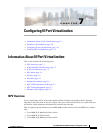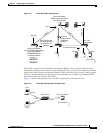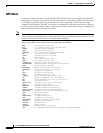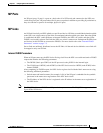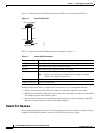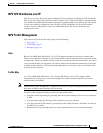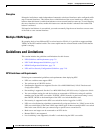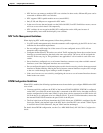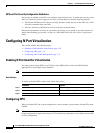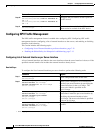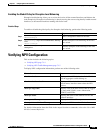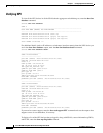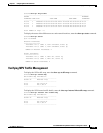
7-8
Cisco MDS 9000 Family NX-OS Interfaces Configuration Guide
OL-29284-01, Release 6.x
Chapter 7 Configuring N Port Virtualization
Guidelines and Limitations
Disruptive
Disruptive load balance works independent of automatic selection of interfaces and a configured traffic
map of external interfaces. This feature forces reinitialization of the server interfaces to achieve load
balance when this feature is enabled and whenever a new external interface comes up. To avoid flapping
the server interfaces too often, enable this feature once and then disable it whenever the needed load
balance is achieved.
If disruptive load balance is not enabled, you need to manually flap the server interface to move some
of the load to a new external interface.
Multiple VSAN Support
By grouping devices into different NPV sessions based on VSANs, it is possible to support multiple
VSANs on the NPV-enabled switch. The correct uplink must be selected based on the VSAN that the
uplink is carrying.
Guidelines and Limitations
This section includes the guidelines and limitations for this feature:
• NPV Guidelines and Requirements, page 7-8
• NPV Traffic Management Guidelines, page 7-9
• DPVM Configuration Guidelines, page 7-9
• NPV and Port Security Configuration Guidelines, page 7-10
NPV Guidelines and Requirements
Following are recommended guidelines and requirements when deploying NPV:
• NPV core switches must support NPIV.
• You can have up to 100 NPV devices.
• Nondisruptive upgrades are supported. See the Cisco MDS 9000 Family NX-OS Fundamentals
Configuration Guide.
• Port tracking is supported. See the Cisco MDS 9000 Family NX-OS Security Configuration Guide.
• You can configure zoning for end devices that are connected to NPV devices using all available
member types on the NPV core switch. If fWWN, sWWN, domain, or port-based zoning is used,
then fWWN, sWWN or the domain/port of the NPV core switch should be used.
• Port security is supported on the NPV core switch for devices logged in via NPV.
• NPV uses a load-balancing algorithm to automatically assign end devices in a VSAN to one of the
NPV core switch links (in the same VSAN) upon initial login. If there are multiple NPV core switch
links in the same VSAN, then you cannot assign a specific one to an end device.
• Both servers and targets can be connected to an NPV device.
• Remote SPAN is not supported.
• Local switching is not supported; all traffic is switched using the NPV core switch.




